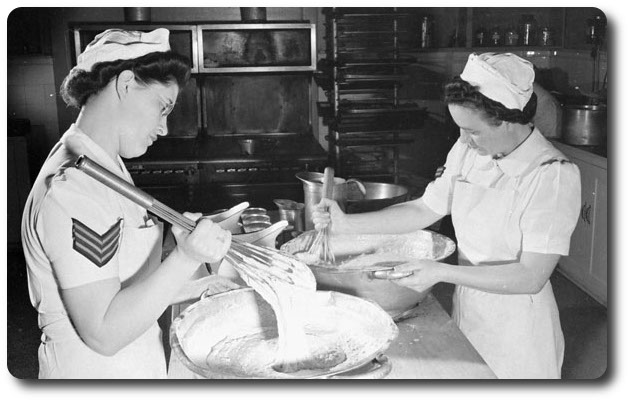Topic: Army Rations

Unidentified airwomen preparing food in the test kitchen, No.1 Nutritional Laboratory, R.C.A.F., Guelph, Ontario, Canada, 3 April 1944. Location: Guelph, Ontario, Canada. Date: April 3, 1944. Photographer: Unknown. Mikan Number: 3583196 Visit the virtual exhibition Faces of War.
Feeding Canada's Forces (1940)
Canada's Greatest Housekeeper May Buy Food By Gallon or Ton But Only Accepts Best Quality
Responsibility for the feeding of all armed forces in Canada, which each month consume tons of butter, meats, cereals and jam, belongs to the foodstuffs section of the Munitions and Supply Department, referred to at times as Canada's greatest housekeeper.
Like any group of healthy, hard-working youth, Canada's growing family of soldiers, sailors and flyers works up a big appetite during each day's operations, and comes clamoring for its three husky meals.
Some idea of the gargantuan appetite of the army, navy and air force can be grasped from a supply department statement that 305 tons of butter were purchased to feed Canada's armed forces during the three months ended June 30.
Like any conscientious housekeeper, the Supply Department has its hands full in buying the best quality products and seeing that its boys get well-balanced meals and plenty of pure, wholesome food.
Every product must come up to specifications based on government standards, and supplies are reckoned in tons and gallons instead of pounds and quarts.
Supplies for a larder properly stocked to last one camp for a single month, according to the Supply Department, include 10 tons of corn beef, 49 tons of vegetables, 135 tons of potatoes, three tons of honey, 4 1/2 tons of cracked and rolled wheat, 9 1/2 tons of jam and two tons each of tea and coffee.
The Supply Department has nine buying centers across the Dominion to facilitate its food purchases. Tenders are issued specifying quantities and qualities, delivery dates and points of delivery.
Fish in Variety
For example, the tender forms for fish list a dozen varieties of fresh fish, including halibut, haddock, shad, sole and pickerel as well as fresh fillets and smoked fish. It states the exact form of each type---with or without head and fins, and other culinary details, and concludes by specifying that the quality must meet with the approval of the officer to whom it is delivered.
Milk specifications include exact standards for everything from butter-fat content to pasteurization temperature.
All standard kinds of meat except veal are purchased, as well as canned foods ranging from butter and fruit to soups, boiled dinners and beef stews. Canned foods are largely destined for naval use, and are particularly useful on the smaller craft engaged in defending Canadian shores, the Supply Department said.
Canadian soldiers top off their meals with such items as apples, jam, raisins, corn syrup, prunes, molasses, honey and maple syrup.

